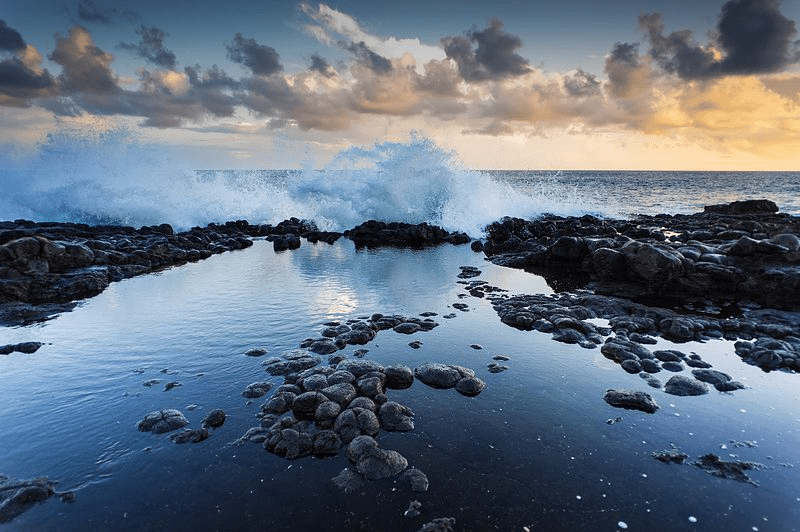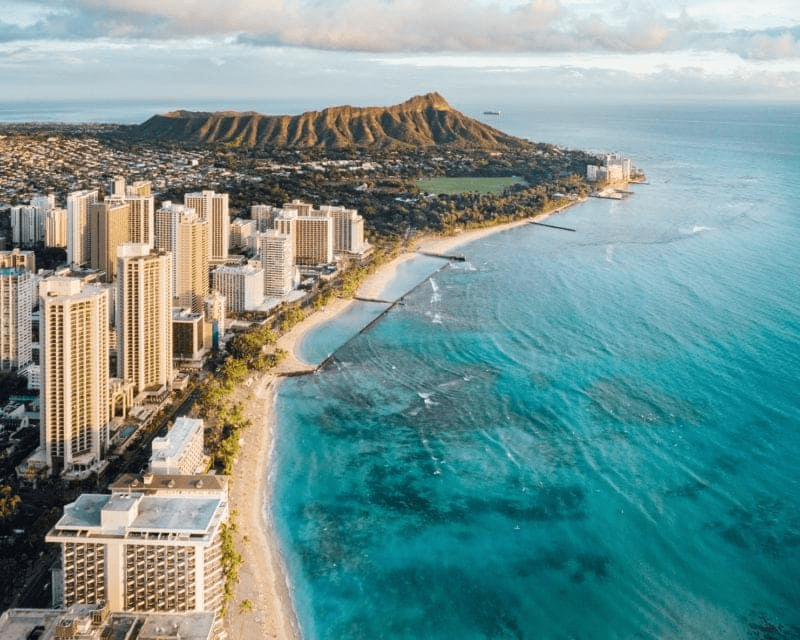Hawaii is a paradise; individuals who visit often discover that the low-key atmosphere and stunning surroundings help them rapidly enter a calm, relaxed attitude. However, be careful not to let your easygoing attitude lead you into trouble; many guests in Hawaii often make common mistakes. Some mistakes only cause discomfort, akin to a severe sunburn. Others, meanwhile, have more harmful and long-lasting effects. Here, we go over Hawaii’s common mistakes and how to avoid or be prepared for them.
1. Turning your back to the ocean
From floating and swimming to boating and surfing, the ocean is the main leisure space available in Hawaii. Sadly, many visitors lack familiarity with the ocean, leading to numerous mishaps and catastrophes. As we will see in the next paragraph, swimming in deep water carries substantial risk from rough waves. However, many injuries occur near shore when people simply overlook the approaching waves. Never turning your back on the ocean is a common mistake in Hawaii. This guideline covers swimming where you cannot stand and standing ankle-deep in the surf, regardless of wave size. Always look forward and concentrate on what is approaching you. Many individuals become distracted, allowing waves to blindside them and cause harm. Though it sounds like common sense, both children and adults find it rather simple to get sidetracked; even modest waves have enough force to knock someone over. While recreating, keep your eyes on the sea to prevent problems.

2. Underestimating the ocean’s power
Underestimating the power of the ocean is another common mistake in Hawaii. Hawaii’s unusual position in the middle of the Pacific gives its waters powerful currents and an element of unpredictability. One minute, the ocean may seem peaceful and pleasant; then, without surprise, it will sweep you out to sea. From shore, waves that seem small and under control are far smaller than they actually are. Before swimming in the sea, always ask the lifeguard about the state of the currents. If the current drags you out to sea, swim parallel to the coast until it releases itself. If in doubt, stay indoors; swim only at beaches under lifeguarded control to guarantee your safety.
3. Climbing on Lava Rock Near the Coast
Climbing on lava rocks near the coast is another common mistake in Hawaii. One only has to pay a quick visit to YouTube or social media to see several illustrations of just how agonizing this experience can be. When exploring under calm conditions, tidepools and other coastal formations can be fascinating. One must be rather conscious, though. Big and small waves can collide with rocks, knocking people over and/or creating slick conditions. Lava rock is extremely sharp and merciless, resulting in cuts, scraps, and serious abrasions from falls.
Dragging across the rocks and into the sea is a regrettable but somewhat regular cause of death or major injury is the most Common mistakes in Hawaii. Explore coastal regions with excellent awareness. When faced with uncertainty, take a step back and observe from a distance.

4. Crossing paths with jellyfish
Every month, jellyfish find their way into Hawaiian seas, presenting swimmers with an awkward meeting. The good news is that their appearance is quite predictable. Typically appearing one to two weeks after the full moon, jellyfish serve as lifeguards, effectively posting warning signs; often, the threat subsides within a few days. Calendars like this one help to approximate the jellyfish arrival. If you find yourself common mistakes in Hawaii at this time, relax. Although you should be especially alert, you can protect yourself from stings by donning a thick rash guard. At lifeguarded beaches, swim to get quick treatment or help if a bad sting strikes.

5. Swimming in fresh water with open cuts
Are you excited about swimming in the pool beneath the waterfall hike? Before you plunge in, be sure you examine yourself for cuts. Swimming in fresh water with open cuts is a common mistake in Hawaii. Leptospirosis is a dangerous bacterium sometimes found in fresh water supplies from Hawaii. It comes into the body via open wounds and can produce fever, headaches, chills, muscular discomfort, and vomiting. The Hawaii Department of Health estimates that half of US leptospirosis cases occur in Hawaii. If you have any kind of cut, minor or major, you should avoid swimming in fresh water when visiting.

6. Trespassing on private property
Although this sounds simple—you wouldn’t do it anywhere—more people trespass in Hawaii than you might believe. Sadly, many guidebooks even encourage this kind of action when referring tourists to illegal trails or sites across private land. In Hawaii (or anywhere), trespassing on private property is a common mistakes in Hawaii. A beneficial rule of thumb is to constantly be conscious that you are a guest and that you are not entitled to visit anyplace you choose. Stay on approved paths and pay attention to any posted signage. While most people in Hawaii are innocent when they trespass, this behavior has become increasingly common as many residents have reached their limit of tolerance. Consider your actions and make an effort to be a pleasant guest.

7. Mistiming Your Scuba Dive
Traveling divers to Hawaii will discover an amazing underwater environment. Just make sure your dives fit your timetable. Generally speaking, one should not travel for 12 to 24 hours after scuba diving. The depth and degree of the dive, as well as the maximum height of the flight, will determine the exact time; however, to be safe, one should schedule a whole 24 hours between their last scuba dive and flight to avoid any health concerns or difficulties resulting from decompression sickness. Seeing the peak on Mauna Kea imposes similar limitations. Island-hopping and traveling every few days causes many people to have timing problems. Mistiming your scuba dive is a common mistake in Hawaii. Divers should pause, especially to coordinate their dives in line with their flights. If diving is your first concern, you might want to plan a few buffer days in case bad weather causes a delay to your dive.

8. Not wearing (or reapplying) reef-safe sunscreen
Not wearing or reapplying reef-safe sunscreen is a common mistake in Hawaii. People often make the mistake of not regularly using or reapplying reef-safe sunscreen. Though many people think of Hawaii as a couple of hours off California’s coast, it is really far south in the Pacific, near the equator, where the sun is brightest. Neglecting the early and frequent application of sunscreen will result in severe burns. The second mistake people make is selecting the wrong type of sunscreen. In 2021, Hawaii became the first state in the US to forbid the sale of sunscreen, including the chemicals oxybenzone and octinoxate, which have proven to harm underwater reefs. Make sure the sunscreen you choose does not have these two compounds. Verify the ingredients carefully, as some sunscreens may bear the label “reef-safe” despite containing one or both of these compounds.

9. Hiking in heavy rain
At Love Big Island, we enjoy hiking in the rain. Less people are on the trail; it’s cooler without the sun, and the rain is the best way to really see a rainforest come alive. Hiking in moderate and severe rain differs greatly, though. While the latter adds major risk and possible danger, the former gives the trip some ambiance and mystery. Hiking in heavy rain is a common mistake in Hawaii. Strong rain will cause the paths to become muddy and slippery, therefore raising the chance of a violent fall. Rising streams also make flash floods or risky crossings possible. For instance, the video below illustrates how unexpectedly strong storms and heavy rain change the Kalalau route on the Napali Coast from somewhat challenging to life-threateningly severe.
10. Visiting Hawaii Without Leaving Waikīkī
Visiting Hawaii without leaving Waikīkī is a common mistake. This truly has nothing to do with whether you visit or not. Typically, Waikiki Beach is not only the most affordable place to stay on O’ahu, but it also boasts the closest proximity to various conveniences. Besides, Waikiki Beach is absolutely unmatched! So, if you dare, visit and appreciate it. Still, avoid making your only visit here. Not reflective of the whole picture as it relates to Hawaiʻi and Hawaiian lifestyle or values, Waikīkī is far different than any other place in the islands. When visiting Hawaiʻi, make sure Waikīkī is on your trip, not the full vacation. Discover the varied landscapes and little settlements of Oʻahu, then, if at all possible, hop to another island. Your perspective on the Hawaiian way of life will be more complete.

11. Choosing the wrong island
Choosing the wrong island is a common mistake in Hawaii. Is there any other island you should visit? You know you ought to. Should you just make a choice at random? Perhaps, but most definitely not. Although they both have access to the sea, the islands differ greatly enough that, if you’re unaware of them, they could prove to be a bust. For example, you might be excited about a laid-back, easy-going beach vacation on the Big Island, unaware that its beaches are young and rocky and that everyday island exploration requires a lot of driving. You would be far better off on Maui and Oahu, where many white-sand beaches encircle small, easily navigable beach communities.
By being aware of these common mistakes in Hawaii, you can ensure a safer and more enjoyable trip. Whether it’s respecting local customs or being cautious around the ocean, these tips will help you make the most of your Hawaiian adventure.

